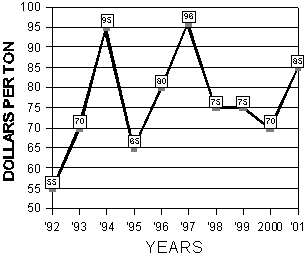Alfalfa Report
Yuma County, Arizona
July 2, 2001
Yuma County Office
2200 W. 28th Street, Ste. 102
Yuma, AZ 85364
(520) 726-3904
(520) 726-8472 FAX
Production Update:
PDF version, 14KB
Alfalfa Moisture: Standing alfalfa is usually at a moisture content of 75 to 85%. Alfalfa cut for silage is usually wilted to 45 to 65% moisture. Haylage is low moisture silage and can have a moisture content as low as 40%. Baled hay with moisture content between 30 and 40% is in the range where fire is a hazard. Baled hay between 20 and 30% moisture can turn brown and moldy unless a preservative is used. Leaf shattering can occur at a moisture content as high as 25%, but baling at less than 20% moisture is recommended to avoid mold growth.
Insect Management: Webworms (afalfa webworm, beet webworm and garden webworm) are occasional pests of desert alfalfa. The larvae of these small moths are slender, usually greenish yellow, stripped or spotted caterpillars which may reach an inch in length. Webworm larvae devour leaves beneath silken webs on the upper parts of plants in summer and fall. They do not cause serious economic damage. Harvesting infested hay greatly reduces the numbers in the next crop cycle.
Weed Control: Summer annual grasses typically begin to emerge
in the spring and continue to germinate until November. With the exception
of sandbur and sprangletop, they can be controlled post-emergence with
Poast or Select. Two applications will be necessary to achieve season
long control. Always use a crop oil concentrate rather than a nonionic
or silicone surfactant.
| Market Summary |
High
|
Low
|
Average
|
Off grade
|
| Past 2 Weeks (June 19 to July 1, 2001) |
90
|
80
|
85
|
70-80
|
| Last Year (June 19 to July 1, 2000) |
75
|
65
|
70
|
50-60
|
10 Year Summary (June 19, to July 1, 1992-2001):

Issued in furtherance of Cooperative Extension work, acts of May 8 and June 30, 1914, in cooperation with the U.S. Department of Agriculture, James A. Christenson, Director Cooperative Extension, College of Agriculture and Life Sciences, The University of Arizona.
The University of Arizona is an equal opportunity, affirmative action institution. The University does not discriminate on the basis of race, color, religion, sex, national origin, age, disability, veteran status, or sexual orientation in its programs and activities.
Any products, services, or organizations that are
mentioned, shown, or indirectly implied in this web document do not imply
endorsement by The University of Arizona.
Information provided by:
Barry Tickes, btickes@ag.arizona.edu Extension Agent, Yuma County
Michael Ottman, mottman@ag.arizona.edu Agronomy Specialist
College of Agriculture, The University of Arizona.
Eric Natwick, etnatwick@ucdavis.edu UCCE Imperial County - Farm Advisor
University of California, Davis, CA.
Material written July 2, 2001.
Forages: Crop Mgmt | Soil Mgmt | Irrigation | Alfalfa Reports | Insects | Diseases | Weeds | Pesticides
Home | Other Crops | Forages
For more Arizona Production Ag Information:
Home | Cotton | Veggies| Forages | Grains | Citrus | Crop x Crop | Insects | Diseases| Weeds | Pesticides | News | Weather | Research | Photos | Contacts | General Info. | Site Map
Copyright © 2001 University of Arizona,
College of Agriculture and Life Sciences
Webmaster: Al Fournier (fournier@ag.arizona.edu)